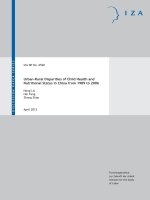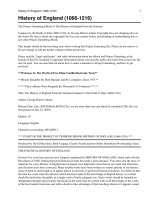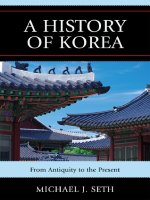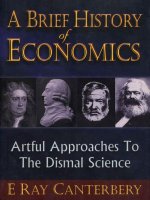The economic history of CHINA from antiquity to the 19th
Bạn đang xem bản rút gọn của tài liệu. Xem và tải ngay bản đầy đủ của tài liệu tại đây (8.78 MB, 619 trang )
T HE E CO NO MIC HIS TO RY O F CHINA
China’s extraordinary rise as an economic powerhouse in the past two decades poses a challenge to
many long-held assumptions about the relationship between political institutions and economic
development. Economic prosperity also was vitally important to the longevity of the Chinese empire
throughout the preindustrial era. Before the eighteenth century, China’s economy shared some of the
features – such as highly productive agriculture and sophisticated markets – found in the most
advanced regions of Europe. But in many respects, from the central importance of irrigated rice
farming to family structure, property rights, the status of merchants, the monetary system, and the
imperial state’s fiscal and economic policies, China’s preindustrial economy diverged from the
Western path of development. In this comprehensive but accessible study, Richard von Glahn
examines the institutional foundations, continuities, and discontinuities in China’s economic
development over three millennia, from the Bronze Age to the early twentieth century.
R I C H A R D V O N G L A H N is
Professor of History at the University of California, Los Angeles. He
has previously published three monographs on Chinese history, including Fountain of Fortune:
Money and Monetary Policy in China, 1000–1700 (1996) and The Sinister Way: The Divine and
the Demonic in Chinese Religious Culture (2004), and a co-authored textbook on world history,
Crossroads and Cultures: A History of the World (2012).
T H E E C O N O M I C H I S T O RY O F
CHINA
From Antiquity to the Nineteenth Century
Richard von Glahn
University of California, Los Angeles
University Printing House, Cambridge CB2 8BS, United Kingdom
Cambridge University Press is part of the University of Cambridge.
It furthers the University’s mission by disseminating knowledge in the pursuit of education, learning and research at the highest
international levels of excellence.
www.cambridge.org
Information on this title: www.cambridge.org/9781107030565
© Richard von Glahn 2016
This publication is in copyright. Subject to statutory exception and to the provisions of relevant collective licensing agreements, no
reproduction of any part may take place without the written permission of Cambridge University Press.
First published 2016
Printed in the United Kingdom by Clays, St Ives plc
A catalogue record for this publication is available from the British Library
Library of Congress Cataloguing in Publication data
Von Glahn, Richard.
An economic history of China : from antiquity to the nineteenth century / Richard von Glahn, University of California, Los
Angeles.
pages cm
Includes bibliographical references and index.
ISBN 978-1-107-03056-5 (Hardback : alk. paper) – ISBN 978-1-107-61570-0 (Paperback. : alk. paper) 1. China–Economic
conditions–To 1644. 2. China–Economic conditions–1644–1912. I. Title.
HC427.6.V66 2015
330.951–dc23 2015031124
ISBN 978-1-107-03056-5 Hardback
ISBN 978-1-107-61570-0 Paperback
Cambridge University Press has no responsibility for the persistence or accuracy of URLs for external or third-party internet
websites referred to in this publication, and does not guarantee that any content on such websites is, or will remain, accurate or
appropriate.
In memory of Ken Sokoloff
Contents
List of figures
List of maps
List of tables
Acknowledgments
Introduction
1 The Bronze Age economy (1045 to 707 B C E )
2 From city-state to autocratic monarchy (707 to 250 B C E )
3 Economic foundations of the universal empire (250 to 81 B C E )
4 Magnate society and the estate economy (81 B C E to 485 C E )
5 The Chinese-nomad synthesis and the reunification of the empire (485 to 755)
6 Economic transformation in the Tang-Song transition (755 to 1127)
7 The heyday of the Jiangnan economy (1127 to 1550)
8 The maturation of the market economy (1550 to 1800)
9 Domestic crises and global challenges: restructuring the imperial economy (1800 to 1900)
Bibliography
Index
Figures
1.1 Configuration of landholdings recorded in the fifth-year Wei Ding inscription
2.1 Archaeological reconstruction of Linzi
2.2 Archaeological reconstruction of Xiadu
3.1 Juyan passport
4.1 Mural of Han Manor, Holingor, Inner Mongolia
4.2 Tomb relief from Chengdu. Late Han dynasty
6.1 Northern Song registered population and lands, 980–1110
8.1 Rice and cotton prices in Jiangnan, 1644–84
8.2 Growth of the money supply, 1726–1833
8.3 Population change in China, 1660–1850
8.4 Population density and rates of growth, 1776–1820
8.5 Grain prices in South China, 1660–1850
8.6 Silver and copper prices of rice in eighteenth-century Guangdong
9.1 Nominal and real GDP estimates, 1600–1840
9.2 Nominal and real per capita GDP estimates, 1600–1840
9.3 Ministry of revenue silver treasury reserves, 1686–1842
9.4 Prices of agricultural and manufactured goods in Ningjin (Hebei), 1800–50
9.5 Prices and wages (silver equivalents) in Ningjin (Hebei), 1800–50
9.6 Daily wages of unskilled laborers in Beijing, 1807–38
9.7 Tea and silk exports, 1756–1833
9.8 Silver:bronze coin exchange ratios, 1790–1860
9.9 Customs revenues, 1796–1850
9.10 Chinese silk exports, 1844–1937
9.11 Shanghai’s trade balance, 1882–1901
Maps
1.1 The Zhou royal domains
2.1 Major states of the Spring and Autumn era, 771–481 BCE
2.2 Major states of the Warring States era, 481–221 BCE
2.3 The distribution of bronze currency types in the Warring States era
2.4 Warring States cities, based on archaeological excavations
2.5 Urban sites and economic activities in the Warring States period
3.1 Early Han China
3.2 Iron and salt production in Han China
3.3 Spatial structure of the Han Empire
4.1 Regional population densities in Han China, 2 CE
4.2 Han commercial centers
4.3 Irrigation on the Shaoxing Plain in Han times
5.1 Expansion of the Northern Wei state
5.2 Distribution of fubing garrisons in early Tang
5.3 Revenues and logistics in Tang China
5.4 Silk and hemp regions in the Northern Wei
5.5 Silk Road trade routes
6.1 Population of Tang China, 742
6.2 Population of Northern Song China, 1102
6.3 Fiscal resources of the late Tang state
6.4 Ecology of the Yangzi River Delta
6.5 Land reclamation of Jian Lake in Shaoxing
6.6 Tea production in southeastern China, 1162
6.7 Distribution of commercial tax revenues, 1077
6.8 Towns in Southern Song Huzhou
7.1 Military procurement in the Southern Song
8.1 Sericulture and cotton production in Jiangnan
8.2 Origins of Shanxi merchants
8.3 Territorial expansion of the Qing state
8.4 Flow of grain trade along major commercial routes in eighteenth-century China
8.5 Macroregional structure of late imperial China
9.1 Mid-nineteenth-century rebellions
9.2 The treaty port network
Tables
2.1 City sizes in the Warring States period
3.1 “Submitted account” for Donghai commandery, 13 BCE
3.2 Service and exemption registers for Nan Commandery, c. 139 BCE
3.3 Population and suanfu registration, Dongyang County, c. 119 BCE
3.4 Seed loan roster for Zheng li
3.5 Servant figurines in the Fenghuangshan tombs
3.6 Estimated government revenues in the Western Han
4.1 Regional population densities in Han China, 2 CE
4.2 West Canton register of households and persons, 139 BCE
4.3 Population figures from Zoumalou (Changsha) registers, c. 235
4.4 Age distributions in Han population registers
5.1 Land allocations under the Northern Wei equal-field system
5.2 Register of equal-field land allocations in Dunhuang, 547
5.3 Estimated state revenues and expenditures in the Northern Wei
5.4 Income of the Department of Public Revenue, c. 742–55
6.1 Suzhou prefecture tax revenues, c. 861
6.2 Landholdings in tenth-century Dunhuang
6.3 Labor intensity of principal crops
6.4 Cultivated land and grain output in Jiangnan rice agriculture
6.5 Estimated net income of Jiangnan rice-farming households
6.6 Coin revenues in the Northern Song
6.7 Principal state revenues in the Northern Song
6.8 Decennial averages of central government revenues, 960–1059
6.9 Issue of bronze currency in Northern Song
6.10 State income and expenditures in 1093
7.1 Government revenues, 1172
7.2 Revenues of the Huaidong General Commissariat, c. 1164
7.3 Central government cash revenues in the Southern Song
7.4 Cash outlays in Fuzhou prefecture, Fujian, c. 1182
7.5 Volume of huizi paper currency in circulation in the Southern Song
7.6 Commercial tax revenues in Southern Song Jiangnan
7.7 Li Shu household and its landholdings, 1391–1432
8.1 Estimates of silver imports to China, 1550–1645
8.2 Grain and money revenues in Ming China
8.3 Central government revenues, 1766
8.4 Grain and money revenues in Ming and Qing China
8.5 Population of Qing China
8.6 Regional variation in tenancy systems
8.7 Registered households and landholdings, Huolu county (Hebei), 1706–1771
8.8 Patrician and Plebeian large landowners in Huolu county, 1706–1771
8.9 Ownership changes in the Wanquantang medicine shop
8.10 Equity shareholders in the Wanquanhao cotton goods store
8.11 Pawnbrokerage interest rates, seventeenth–twentieth centuries
9.1 Household consumption expenditures of Jiangnan farming families, eighteenth century to
1930s
9.2 Work days per mu in Jiangnan agriculture
9.3 A model of family income in Jiangnan, sixteenth to eighteenth centuries
9.4 Estimates of Chinese GDP
9.5 Net flow of silver from China, 1818–54
9.6 Customs revenues, 1725–1831
9.7 Government revenues in the late Qing
9.8 Estimates of China’s money supply, c. 1910
9.9 China’s foreign debt, 1853–94
9.10 Estimated financial resources of Shanxi banks, 1850s–1910s
Acknowledgments
For two decades I had the immense good fortune of having an office adjoining that of Ken Sokoloff,
one of our most distinguished scholars of economic history. Through his unflagging good cheer, robust
wisdom, and ecumenical knowledge of economics and history, Ken was a steadfast source of support
for my own research and writing in Chinese economic history. One could not hope for a finer
colleague, or imagine a finer person. His untimely death has been an enormous loss for the field of
economic history – as numerous eulogists have already attested. I deeply regret that Ken did not live
to see this book – which in ways large and small he encouraged and nurtured – appear in print. I can
only acknowledge my appreciation by dedicating it to his memory, and to the ideals of scholarly
community that he, more than anyone I have ever known, embodied.
R. Bin Wong and Jean-Laurent Rosenthal read drafts of each chapter and generously provided
me with cogent advice and provocative criticism. I am beholden to them and to the student
participants in the Cal Tech-UCLA Workshop on Chinese Economic History during the past several
years – Xiang Chi, Xiaowen Hao, Yifei Huang, Sunkyu Lee, Guillermo Ruiz-Stoval, Dong Yan, and
Meng Zhang – who also sacrificed their time and energy in reading and commenting on the entire
manuscript. I have also keenly benefited from the comments and corrections provided by Lothar von
Falkenhausen, Anthony Barbieri-Low, and Maxim Korolkov, each of whom read several of the early
chapters of the book manuscript. I have not been able to address all of the issues raised by these
readers, but their efforts have improved it significantly. Omissions are inevitable in a synthetic study
like this, and no doubt errors have crept in as well; I assume responsibility for any shortcomings.
The immense debt I owe to the legions of scholars whose research has informed this study
should be readily apparent, even if my references to their writings and ideas only imperfectly
acknowledge their contributions. I have been extremely fortunate to receive the financial support of a
fellowship from the National Endowment for the Humanities in 2010–11, which launched the writing
of this book, and also a Guggenheim Fellowship in 2013–14 that enabled me to finish the writing in
timely fashion. And finally, although words scarcely suffice for the task, I wish to express my
gratitude to Kayoko and Erika for making this journey a joyous one.
Introduction
◈
Until the 1960s, historians viewed China’s history – and especially its economic history – through the
lens of Western teleologies of historical change predicated on the progress of “freedom,” leading
either to capitalist democracy or socialist utopia. As I have written elsewhere, whether construed in
Weberian terms as a peculiar type of “bureaucratic feudalism” or in Marxist categories as a species
of the “Asiatic mode of production” genus, both Western and Asian scholarship portrayed imperial
China as a static society whose periodic changes in regime barely caused a ripple on the stagnant
pond of despotism.1 The immobility of imperial Chinese society and economy typically was
attributed to the parasitic nature of the imperial state and its dominant social class, the “gentry.”
Although the Chinese empire was believed to share the basic features of “oriental despotisms” in
general, its unique longevity could be explained by the remarkable durability of the gentry’s
dominance over government office, landowning, intellectual life, and culture. In contrast, for example,
to the dispersion of social power among monarchs, warriors, clerics, seigneurs, and urban
corporations in medieval Europe, the gentry monopolized political, economic, and cultural authority
and deflected challenges from any insurgent group, be they merchants, military officers, or disaffected
intelligentsia. In the eyes of Marxist historians, the persistence of gentry rule perpetuated feudal
property ownership and relations of production in which the rentier elite absorbed the surpluses
generated by the peasant families under their dominion. American scholars balked at employing the
category of “feudalism,” given its Marxist associations, but their paradigm of “traditional” Chinese
society essentially conformed to this depiction of economic inertia.
The most potent challenges to this image of an unchanging China were voiced by Japanese
historians. Naitō Kōnan, writing in 1914, was the first to posit a fundamental transformation in
Chinese government and society from the eighth to the twelfth centuries (what has become known as
the “Tang-Song transition”) during which aristocratic domination dissolved and was superseded both
by a more autocratic state and greater autonomy for village society. Naitō’s disciple Miyazaki
Ichisada, in his 1950 book East Asia’s Modern Age, likened the Tang-Song transition to the European
Renaissance, both of which exhibited the secularization of society and culture and the rebirth of
rational philosophy on one hand, and the rise of cities, commerce, and the free disposition of property
and labor on the other, that have become hallmarks of the modern world. 2 Japanese Marxist
historians, in contrast, interpreted the Tang-Song transition as the moment in which a feudal society
based on serfdom eclipsed the ancient slave-labor economy. In their view, in contrast to genuine
forms of feudalism – to be found in the medieval eras of both Europe and Japan – Chinese feudalism
proved resistant to further social development because of the ineluctable tenacity of China’s
patriarchal social institutions of family, lineage, village, and guild.
The crucial breakthrough in the conceptualization of China’s premodern economy came in the
1960s. Shiba Yoshinobu’s magisterial study of the commercial economy of Song China (tenth to
thirteenth centuries) marked a crucial departure from linear conceptions of history to study the facts of
economic life.3 In meticulous detail Shiba reconstructed the innovations in transport, agricultural and
industrial productivity, markets, urban structure, business enterprise, and credit and finance that
stimulated an unprecedented commercial efflorescence. As Shiba demonstrated, the Song period
witnessed the formation of regional, national, and international markets for a wide range of
commodities, including staples such as grain, salt, and timber and new consumer products (tea, sugar,
porcelain) as well as luxury goods. Although Shiba’s study focused on private commerce and the
formation of commercial capital, he disavowed the idea that the rise of the market economy heralded
the emergence of a bourgeois social class. At the same time Robert Hartwell published a series of
provocative essays on the coal and iron industries in Song China that offered further corroboration of
the importance of market demand for industrial development.4 Hartwell’s study attested to prodigious
iron and steel output by large-scale enterprises utilizing technologies such as blast furnaces and
coking far beyond anything available in the West at the time. While primarily stressing the demand for
iron goods emanating from urban markets (and especially the Song capital of Kaifeng), Hartwell also
underscored the contributions of the Song state – in providing domestic peace, a stable monetary
system, transport facilities, and predictable economic policies – in reducing risks and fostering
private investment.
The fruits of the pioneering research by Shiba and Hartwell were gathered together into a far
more ambitious interpretation of China’s premodern economy proposed by Mark Elvin in his seminal
study, The Pattern of the Chinese Past (1973). Elvin divided his analysis of Chinese history into
three parts that surveyed (1) the main features of political economy from the early empires down to
the fourteenth century, with a focus on the military and fiscal capacities of the imperial state; (2) what
Elvin dubbed “the medieval economic revolution” of the eighth to thirteenth centuries, focused on
technological and institutional changes that enabled unprecedented growth in agriculture, industrial
production, commerce, and cities; and (3) the flattening of growth and technological stasis throughout
the late imperial period (from the fourteenth century onward), resulting in what he described as
“quantitative growth and qualitative standstill.” Elvin concluded that the turning point in China’s
economic development came during the fourteenth century, pointing to three changes or reversals that
deterred further investment, material and intellectual, in technological innovation: (1) the diminution
of foreign contact and trade resulting from the Ming state’s self-imposed maritime embargo, which cut
off China from international trade, vitiated its navy, and hindered the development of national
identity; (2) the “filling-up” of China’s frontiers and closing of outlets for emigration, resulting in a
worsening imbalance in the labor/land ratio that discouraged labor-saving innovations; and (3) the
waning of philosophical interest in the natural world and efforts to gain mastery over it, thus
precluding the emergence of “science.” Despite important developments in the late imperial period
(especially during 1550–1800), including the disappearance of serfdom, the growth of rural trade and
industry, and increased scale of economic organization, China remained encased in a technological
cul-de-sac that precluded a breakthrough to an industrial revolution.
Elvin’s book was not intended as a comprehensive economic history, but it did advance a bold
and novel thesis to explain long-term changes in the Chinese economy and its failure to generate the
kind of transformative change wrought by the Industrial Revolution in the West. Equally importantly,
however, Elvin established the idea of a “medieval economic revolution” in China that confounded
the universal categories of Western social science and challenged commonplace assumptions about
the primacy of the Western European historical experience. Historians of late imperial China
responded to Elvin’s contrast between the medieval economic revolution and the merely incremental
pace of subsequent economic growth by asserting that from the sixteenth century onward China
underwent a “second economic revolution” characterized by: the disappearance of bound labor; the
ascendancy of private enterprise over state economic management; the growth of rural industries; the
increasing spatial range of the market; higher levels of monetization in private trade and public
finance; a greater volume of foreign trade; and dramatic increases in the size of the population and
economic output.5
Nonetheless, despite the emerging consensus that the market exerted a growing influence on
economic life from the Song dynasty onward, many scholars shared Elvin’s conviction that China’s
late imperial economy remained trapped in some form of structural equilibrium that prohibited
transformational growth. In contrast to the focus on commercial development in the studies by Shiba,
Hartwell, and Elvin, scholars such as Kang Chao and Philip Huang emphasized the constraints
imposed by the inherent limitations of a peasant economy dominated by small family farms.6 Chao
and Huang argued that the persistence of a peasant mode of production driven by family subsistence
needs inhibited labor-saving technological innovation and the formation of capital-intensive farming.
Access to land and market opportunities ironically reinforced, in Huang’s words, an “involutionary”
pattern of diminishing labor productivity and “growth without development.” Kent Deng singled out
the crucial importance of the “absolute” landownership rights of free peasant families as the key to a
structural equilibrium that in his view was congruent with the development of the Chinese empire
since its origins in antiquity. Deng postulated that the interlocking effects of Confucian ideology, the
imperial state, and the landholding system promoted economic stability, a decent and at times affluent
livelihood, commercial expansion, population growth, and military security, but the strength of this
fundamentally agrarian system also deterred transformative change.7
This notion that China’s economy was constrained by a peasant mode of production has been
disputed by scholars steeped in the tenets of neoclassical economics who argued that farming families
were inculcated with norms of diligence, thrift, and accumulation and responded positively to shifts
in factor prices within smoothly functioning, competitive markets largely free from government
interference. Although the constraints of premodern technologies – especially in transport – limited
the potential for market-driven development, the growth of regional and international markets after
1870 (at least in some favored areas) because of improvements in transport, information, and
technological diffusion generated rising real incomes and sustained economic growth before the onset
of the Great Depression and the Japanese invasions in the 1930s.8 The involution thesis also was
challenged by Li Bozhong’s contention that – in contrast to Elvin’s depiction of technological stasis in
the Ming-Qing era – Chinese farmers continually innovated by developing new agricultural
technologies and investing household labor in handicraft industries that boosted family incomes and
rural prosperity throughout the late imperial era.9
The dispute over the nature of the Chinese rural economy ultimately hinged on the question of
whether it should be understood primarily as a product of China’s unique historical experience – the
most crucial features of which were the predominance of small family farms and a distinct “peasant”
mentality – or, conversely, as one governed by universal laws of economic behavior in which farming
households responded affirmatively to market incentives, behaving much like entrepreneurial firms. In
the 1990s, the search to transcend the apparent stalemate between these conflicting views gave rise to
what has come to be known as the “California School” of Chinese economic history. Applying the
analytical tools of comparative economic history to the study of China’s late imperial economy
framed within a world-historical perspective, the California School group challenged long-standing
assumptions about the inherent superiority of Western institutions, culture, and government for the
promotion of economic growth.10 In his provocative study of the “Great Divergence” that led to the
Industrial Revolution breakthrough in Britain but not elsewhere, Kenneth Pomeranz raised the
question of whether institutional differences in fact produced divergent outcomes in economic
performance.11 Pomeranz contended that despite their different institutional matrices, the most
economically advanced regions of the premodern world – including not only Britain and the
Netherlands in Europe and China’s Yangzi Delta, but also Bengal in India and eastern Japan –
evinced fundamental similarities grounded in what Adam Smith identified as the motive forces of
economic growth: the expansion of markets and the specialization of labor. Pomeranz thus repudiated
Huang’s involutionary model in contending that Chinese farming families and entrepreneurial firms
alike responded efficiently to price-setting markets for land, labor, and capital. At the same time
Pomeranz emphasized the limits to Smithian dynamics of economic growth and the intensifying
constraints to further development, largely due to exhaustion of natural resources, that all of the
leading economic regions of the world faced by the end of the eighteenth century. The breakthrough to
modern economic growth came not from further extension of Smithian market dynamics, but rather
from Britain’s unique advantages for resolving resource constraints through its colonial empire and
for developing the revolution in energy (coal-powered steam technology) that was the true basis for
the Industrial Revolution.
The tempestuous debate over the “Great Divergence” incited by the work of Pomeranz and other
California School historians without doubt has been the most hotly contested issue as well as the most
vitally creative catalyst for new scholarship in the field of comparative economic history during the
past fifteen years.12 The most important influence of the California School scholarship – and what
will be its enduring legacy – has been its insistence on precision and consistency in comparing
economic institutions and performance in Europe, Asia, and beyond. In response to – and the
response overwhelmingly has consisted of efforts at refutation – Pomeranz’s “Great Divergence”
thesis, economic historians have focused intently on developing quantitative measures of economic
performance to test its arguments. As a result, the recent wave of scholarship on the Chinese economy
in comparative historical perspective has mostly been confined to issues and time periods for which
quantitative measurement might be feasible (and yet still, as we shall see, severely hindered by the
limitations of empirical evidence). As a result little of this scholarship examines Chinese economic
history before the eighteenth century. Moreover, for reasons that defy ready explanation, the “Great
Divergence” debate seems to have engaged economists more than historians, and the impetus for new
research stimulated by it has largely come – apart from the California School scholars themselves –
from Asian and European scholars rather than the North American academic community.
As welcome as the new attention to the economic history of China generated by the “Great
Divergence” debate is, the narrow focus of recent comparative scholarship on particular institutions
and quantitative measurement has caused scholars to lose sight of the Chinese economy as a whole
and its historical development. Insufficient attention has been paid to the fact that the value of
institutions always is context-specific; there is no set of institutions that is optimally valid under all
historical circumstances – a point forcefully argued by Pomeranz, but often ignored. The purpose of
this book is to tell the story of the Chinese economy in its own terms; or, perhaps I should say, to
view the story of Chinese history through the lens of economic livelihood. Scholars and students of
Chinese history as well as comparative economic historians presently lack access to even basic
knowledge about Chinese economic history. General economic histories of China have been
published in China – perhaps most authoritatively, the sixteen-volume Comprehensive Economic
History of China (中国经济通史) published by Jingji Ribao Chubanshe (2nd edition, 2007) under
the guidance of eleven editors – but they remain encumbered by shopworn Marxist paradigms and fail
to incorporate virtually any Western scholarship, and Japanese scholarship only intermittently.
Surprisingly, synthetic surveys of Chinese economic history rarely have been attempted by Japanese
scholars in the past half-century. Mention should be made of a recently published volume edited by
Okamoto Takashi, which provides a cogent but highly abbreviated survey of Chinese economic
history from the Neolithic era to the advent of the recent economic reforms launched in 1978.13 But
this work, with some exceptions, draws almost exclusively on Japanese scholarship. Elvin’s Pattern
of the Chinese Past, now more than forty years old, has served – and for the most part served well –
as the basic point of reference for Western scholars and students without command of the Chinese or
Japanese languages, but Elvin’s book was not intended as a comprehensive economic history of
China, and much of its content has been superseded by new knowledge.
This book, which spans nearly thirty centuries from the Bronze Age to the dawn of the twentieth
century, immodestly attempts to fill this void. As the brief synopsis of recent debates over the
premodern Chinese economy delineated above suggests, this field of study is riven by clashing
interpretations, and as the following chapters will show, consensus is elusive on many major issues
for virtually every period of Chinese history. Since this book is intended to be a work of synthesis, I
have striven to achieve balance and objectivity; where I have waded into scholarly controversies and
made my own interpretative choices, I have tried to acknowledge differing opinions and to justify my
own judgments. My allegiance to the California School – as a matter of method, not doctrine – will be
self-evident, but I hope I have succeeded in providing a fair hearing to opposing points of view.
My goal has been to write a coherent, synthetic narrative of the development of the Chinese
economy over the very long term based on the best available scholarship. Of course, given the
constraints of time, space, and resources, omissions are inevitable, and worthy scholarship
undoubtedly has been overlooked in places. I have not proposed an overarching theory of the Chinese
economy; my hope is that in this case, truly “le bon dieu est dans le détail.” But there is indeed a
polemic that underlies this narrative. In the first place, this study repudiates any linear, stadial notion
of history or economic development. Second, it disavows a fundamental tenet of neoclassical
economics, namely the idea that the market is the driving force in economic development and the
creation of wealth. Modern economic growth (and this was true of premodern economic growth as
well) principally derives not from the expansion of markets, but rather from innovations fostered by
new knowledge and technology. The narrow attention economic historians have focused on the market
has obscured the impact of other institutions – most notably, the state – in promoting economic
development.
Needless to say, in the case of China, where the imperial state endured for two millennia, the
presence of the state loomed especially large in the lives and livelihoods of its subjects. As noted
above, the remarkable durability of the imperial state has induced Western social theorists to
categorize China as a form of “oriental despotism” in which the stultifying effects of imperial rule
imparted a profound inertia to political and economic institutions that defied the norms of economic
behavior and economic history. This characterization of Chinese “despotism” has persisted in
Western social science even in recent times. 14 Over the past several decades, Chinese historians
have endeavored to counter this false image by delineating the dramatic expansion of the private
economy since the mid-sixteenth century, the diminished role of the state in governing economic life,
and even the possible emergence of a “civil society” in which the state granted substantial autonomy
to local community leaders. In a different vein, the work of R. Bin Wong has rehabilitated our
understanding of the late imperial Chinese state, refuting the caricature of a despotic and arbitrary
government dedicated to the enrichment and opulence of the sovereign by elucidating the actual goals,
capacities, and commitments of its leadership and the ways in which state actions – not necessarily
deliberately – made positive contributions to economic growth.15 Nonetheless, the conviction that
late imperial China should be seen as a “patronage economy” that “obstructed innovation and also
encouraged widespread corruption” remains widespread, even among scholars who specialize in the
study of the Chinese economy.16
In the study of European history, growing numbers of economists and historians have begun to
recognize that the consolidation of power in the hands of territorial states during the early modern
period enhanced the state’s fiscal and infrastructural capacity and encouraged state interventions to
promote economic welfare that had positive effects on economic growth. Rather than dismissing the
state as an invariably rent-seeking encumbrance continually interfering with the free play of market
forces, this body of scholarship has sought to recuperate the crucial importance of the early modern
state in fostering or abetting economic developments that culminated in the emergence of capitalism
and the Industrial Revolution.17 The state did so through promoting and protecting new knowledge,
investing in public goods, and incubating nascent strategic industries through policies that can be
broadly described as “mercantilist” in the sense defined by Gustav Schmoller in 1884: “the total
transformation of society and its organizations, as well as of the state and its institutions, in the
replacing of a local and territorial economy by that of the national state.”18 Centralization of political
power curtailed seigneurial and urban monopolies, privileges, and jurisdictional authorities that had
hindered market integration, commercial competition, technological diffusion, and industrial
investment.19 War-making, despite the short-term devastation it inflicted, exerted crucial influence on
state formation and long-term economic development.20 Rather than simply an extension of Smithian
dynamics of market expansion and labor specialization, economic growth in early modern Europe
was nurtured by Schumpeterian principles in which it is not perfect markets, but rather imperfect
markets, that spur innovation and economic growth. The quest for national sovereignty and
geopolitical power led not only to an expansion of the fiscal capacity of the state, but also to the
protection of property rights (including intellectual property through patents), investment in “infant”
industries, greater mobility of skilled labor, the acquisition of new technologies, and the creation of
trade networks that extended around the globe.21
We also see this Schumpeterian dynamic at work in Chinese history. The imperial state was not
a monolithic entity. Just as the economy evolved over time, so did the state and its institutions. The
dialectic between the fiscal operations of the state and the wider economy yielded divergent results
under different historical circumstances and ideological commitments. From a Schumpeterian
perspective, at times the Chinese imperial state galvanized economic growth by providing domestic
peace, international security, and investment in public goods – education, welfare, transport systems,
water control, and standardized market institutions – as well as creating an institutional infrastructure
that enabled Smithian growth in agriculture and commerce. The state’s role in creating demand
(including war-making) also figured significantly in stimulating economic development. During the
late imperial era, China’s rulers embraced the Neo-Confucian ideological abhorrence (not unlike that
of neoclassical economics) to state interference in the private economy. Although this commitment to
light taxation and minimal state intrusion – a far cry from the “oriental despotism” imagined by
Western social theorists! – had positive effects in encouraging Smithian dynamics of economic
expansion, the weak infrastructural capacity of the state limited the potential for economic growth
along Schumpeterian lines as was happening concurrently in early modern Europe.
That, at least, is a hypothesis that should be subjected to rigorous research and analysis. This
study will, I hope, provide a new set of benchmarks for comparative economic history, but my
principal intention is to present a coherent narrative of the development of the premodern Chinese
economy. Above all, it is my fervent wish that this study can begin to do justice to a proper
understanding of the lives and livelihoods – and the diversity, imagination, and industry – of the
Chinese people over the past three millennia.
1
For further elaboration of the historiography of imperial China discussed here, see von Glahn
2003a.
2
Miyazaki 1950.
3
Shiba 1968.
4
Hartwell 1962, 1966, 1967.
5
Rowe 1985.
6
Chao 1986; Philip Huang 1985, 1990.
7
Gang Deng 1999.
8
For a summary of this argument and the scholarship supporting it, see Myers 1991.
9
Li Bozhong 1998, 2003.
10
The term “California School” was coined by Jack Goldstone 2000. The seminal works in this
vein of scholarship were Wong 1997 and Pomeranz 2000. Other notable expressions of this
approach (whose analyses and conclusions nonetheless diverged in many respects) include Flynn
and Giráldez 1995; von Glahn 1996a; Lee and Campbell 1997; Frank 1998; Li Bozhong 1998;
Marks 1999; Goldstone 2002; and Sugihara 2003. Among other issues, the California School
scholarship also challenged the common view that integration into the global economy since the
sixteenth century had negative repercussions that impoverished the Chinese population and
subjected China to domination by Western imperialism and capitalism. On this point, see in
particular von Glahn 1996b, Frank 1998.
11
Pomeranz 2000.
12
For further discussion of the debates over the Chinese rural economy and the California School
scholarship, see Chapter 9.
13
Okamoto 2013. Nearly half of the Okamoto volume is devoted to fifty-nine self-contained short
essays (one to three pages each) that provide valuable digests of specific topics and institutions.
14
See Mann 1986, Landes 1998, Macfarlane 2000, and Acemoglu and Robinson 2012 for
influential examples.
15
Wong 1997, 2012.
16
Brandt, Ma, and Rawski 2014: 79. This is only one aspect of the imperial state analyzed by this
group of authors, but in their view the patronage economy is one of the imperial state’s legacies –
and perhaps the main one – that persists in the People’s Republic of China today. See ibid.: 106.
17
I am particularly influenced here by the work of Reinert 1999; Epstein 2000; Reinert and Reinert
2005; and O’Brien 2012. See also Vries 2015, which appeared too late for me to incorporate here.
18
Schmoller 1967: 51. Regrettably, our understanding of the historical role of mercantilist ideas
and policies has largely been shaped by one of mercantilism’s most hostile critics, Eli Heckscher
(1955). For a more historically grounded and balanced assessment of mercantilism, see Magnusson
1994.
19
Epstein 2000.
20
Findlay and O’Rourke 2007; Rosenthal and Wong 2011.
21
Reinert and Reinert 2005; O’Brien 2012.









